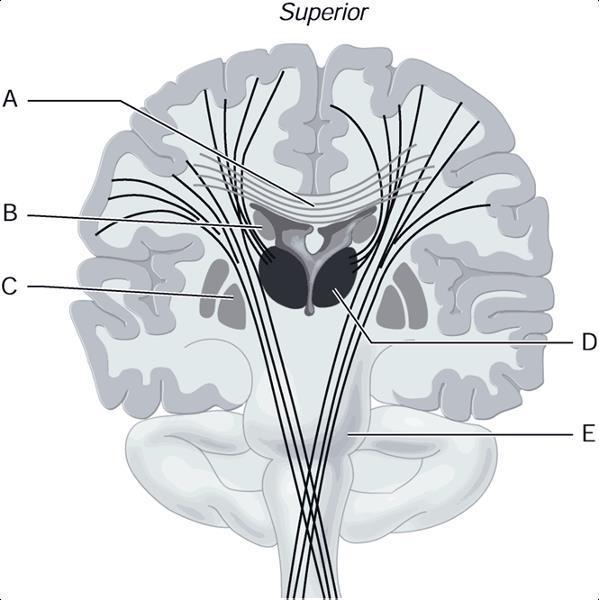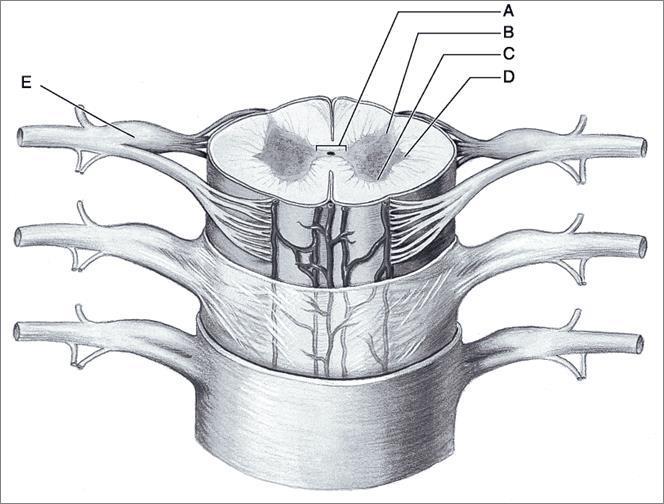
Label the following:
1.) Pons
2.) Corpus Callosum
3.) Caudate Nucleus
4.) Globus pallidus
5.) Thalamus
1.)E
2.) A
3.) B
4.) C
5.) D

1.) Site of efferent soma
2.)Site of axons and afferent neurons
3.)Site of sensory soma
4.) Gray commissure
5.)Horn containing autonomic neurons
6.) Site containing central canal
7.) Multipolar neurons are common here
1.) C
2.) B
3.) E
4.) A
5.) B
6.) A
7.) C
Which brain waves are not normal for awake adults but are common for children?
A) Delta
B) Alpha
C) Theta
D) Beta
C
Loss of ability to perform skilled motor activities such as piano playing, with no paralysis or weakness in specific muscles, might suggest damage to the ________.
A) primary motor cortex
B) spinal cord
C) premotor cortex
D) rubrospinal tracts
C
Second-order neurons of both the specific and nonspecific ascending
pathways terminate in the ________.
A) thalamus
B) spinal cord
C) somatosensory cortex
D) medulla
A
Which of the following is (are) involved with motor activity (either initiation or coordination)?
A) gustatory cortex
B) postcentral gyrus
C) red nuclei
D) Wernicke's area
C
Tremor at rest, shuffling gait, stooped posture, and expressionless
face are characteristics of ________.
A) spinal cord disease
B) cerebellar disease
C) Huntington's disease
D) Parkinson's disease
D
The area of the cortex that is responsible for sensations of the full bladder and the feeling that your lungs will burst when you hold your breath too long is the ________.
A) gustatory cortex
B) vestibular cortex
C) olfactory cortex
D) visceral sensory area
D
Which of the following structures is probably not directly involved in memory? A) hippocampus
B) prefrontal cortex
C) thalamus
D) medulla
D
Injury to the hypothalamus may result in all of the following except ________. A) pathologic sleep
B) loss of proprioception
C) loss of body temperature control
D) production of excessive quantities of urine
B
Which of the following is not a function of the CSF?
A) nourishment of the brain
B) initiation of some nerve impulses
C) reduction of brain weight
D) protection from blows
B
Which category of memory is involved when playing the piano?
A) procedural
B) emotional
C) motor
D) declarative
A
Which part of the cerebral cortex is involved in intellect, cognition, recall, and personality?
A) limbic association area
B) posterior association area
C) combined primary somatosensory cortex and somatosensory association cortex
D) prefrontal cortex
D
Broca's area ________.
A) serves the recognition of complex objects
B) is considered a motor speech area
C) is usually found in the right hemisphere
D) corresponds to Brodmann's area 8
B
Two terms for the massive motor tracts serving voluntary movement are ________.
A) supplementary and cerebellar-pontine
B) extrapyramidal and rubrospinal
C) pyramidal and corticospinal
D) segmental and nigrostriatal
C
Spastic paralysis suggests involvement of the ________.
A) spinal nerve roots
B) lower motor neurons
C) upper motor neurons
D) neuromotor junction
C
An individual accidentally transected the spinal cord between T1 and
L1. This would result in ________.
90)
A) quadriplegia
B) hemiplegia
C) spinal shock only
D) paraplegia
D
The white matter of the spinal cord contains ________.
A) soma that have both myelinated and unmyelinated nerve fibers
B) myelinated nerve fibers only
C) myelinated and unmyelinated nerve fibers
D) unmyelinated nerve fibers only
C
If the caudal portion of the neural tube failed to develop properly the ________. A) telencephalon would cease development
B) cranial nerves would not form
C) spinal cord may be affected
D) hindbrain would not be present
C
A shallow groove on the surface of the cortex is called a ________.
A) gyrus B) fissure C) sulcus D) furrow
C
Cell bodies of the sensory neurons of the spinal nerves are located in ________. A) the dorsal root ganglia of the spinal cord
B) the thalamus
C) sympathetic ganglia
D) the ventral root ganglia of the spinal cord
A
The vital centers for the control of heart rate, respiration, and
blood pressure are located in the ________.
A) pons B) medulla C)
cerebrum D) midbrain
B
The subarachnoid space lies between what two layers of meninges?
A) arachnoid and dura
B) arachnoid and pia
C) dura and epidura
D) arachnoid and epidura
B
Spinocerebellar tracts ________.
A) terminate in the spinal cord
B) are found in the dorsal columns of the spinal cord
C) give rise to conscious experience of perception
D) carry proprioceptive inputs to the cerebellum
D
What cells line the ventricles of the brain?
A) epithelial cells
B) ependymal cells
C) astrocytes
D) neurons
B
The arbor vitae refers to ________.
A) cerebellar white matter
B) flocculonodular nodes
C) the pleatlike convolutions of the cerebellum
D) cerebellar gray matter
A
Which brain nucleus is the body's "biological clock"?
A) lentiform nucleus
B) suprachiastmatic nucleus
C) subthalamic nucleus
D) dorsomedial nucleus
B
True or False: Embryonic damage to the mesencephalon could result in improper formation of the midbrain
True
True or False: NREM sleep normally exhibits four distinct stages, which appear to alternate
True
True or False: Nuclei relating to the startle reflex are located in the corpora quadrigemina of the midbrain
True
True or false: A flat EEG is a good indication of deep sleep
False
True or False: The three basic regions of the cerebrum are the cerebral cortical gray matter, internal white matter, and the superior and inferior colliculi.
False
True or False: Cell bodies of the somatic motor neurons of the spinal nerves are located in the ventral horn of the spinal cord.
True
True or False: The adult spinal cord ends between L1and L2
True
True or False: Cerebrospinal fluid circulates within the ventricles of the brain and in the subarachnoid space
True
The RAS is comprised of specific pathways primarily in the limbic system
False
The left cerebral hemisphere is usually dominant
True
Commissural fibers connect the cerebrum to the diencephalon.
False
1.)Where nerves serving the upper limbs arise
2.) Anchors the
spinal cord in place
3.) Collection of nerve roots at the
inferior end of the vertebral canal
4.) Point of termination of
the spinal cord in an adult
A) Conus medullaris
B) Filum terminale
C) Cervical
enlargement
D) Cauda equine
1.) C
2.) B
3.)C
D.)4
1.)Gateway to the cerebrum
2.) Motor command center
3.)
Survival center
4.) Executive suite
5.) Visceral command center
A) Thalamus
B) Cerebellum
C) Brain stem
D)
Hypothalamus
E) Cerebrum
1.) A
2.) B
3.) C
4.) E
5.) D
1.) The stage when vital signs (blood pressure, heart rate, and body
temperature) reach their lowest normal levels.
2.) Indicated by
movement of the eyes under the lids; dreaming occurs.
3.) Theta
and delta waves begin to appear.
4.) Very easy to awaken; EEG
shows alpha waves; may even deny being asleep.
5.) Typified by
sleep spindles.
6.) Begins about 90 minutes after the onset of
sleep.
7.) Necessary for emotional health; may be neural "debugging."
A) Stage 4
B) Stage 3
C) REM
D) Stage 1
E)
Stage 2
1.) A
2.) C
3.) B
4.) D
5.) E
6.) C
7.) C
1.)A major relay station for sensory information ascending to primary
sensory areas of the cerebral cortex. Contains many specialized
nuclei.
2.) This brain area associates experiences necessary for
the production of abstract ideas, judgment, and conscience.
3.)
The axons from this area form the major pyramidal tracts.
4.)
This area is the main visceral control center of the body.
A) Thalamus
B) Hypothalamus
C) Primary motor
cortex
D) Prefrontal area
1.) A
2.) D
3.) C
4.) B
1.)Auditory area.
2.) Primary sensory cortex.
3.) Somatic
motor cortex.
4.) Motor speech area.
5.) Premotor area.
6.) Visual area.
7.) Taste (gustatory) area.
8.) Seat
of intelligence, abstract reasoning.
1.) C
2.) A
3.) B
4.) B
5.) B
6.) E
7.) D
8.) B